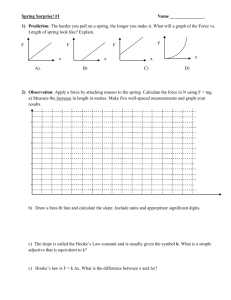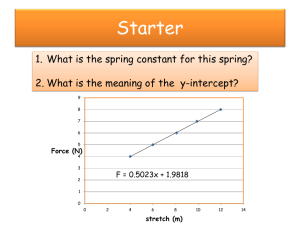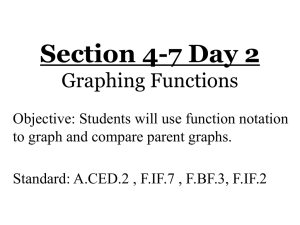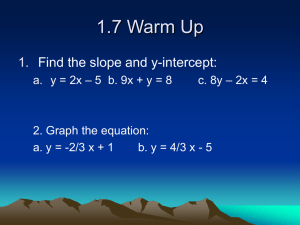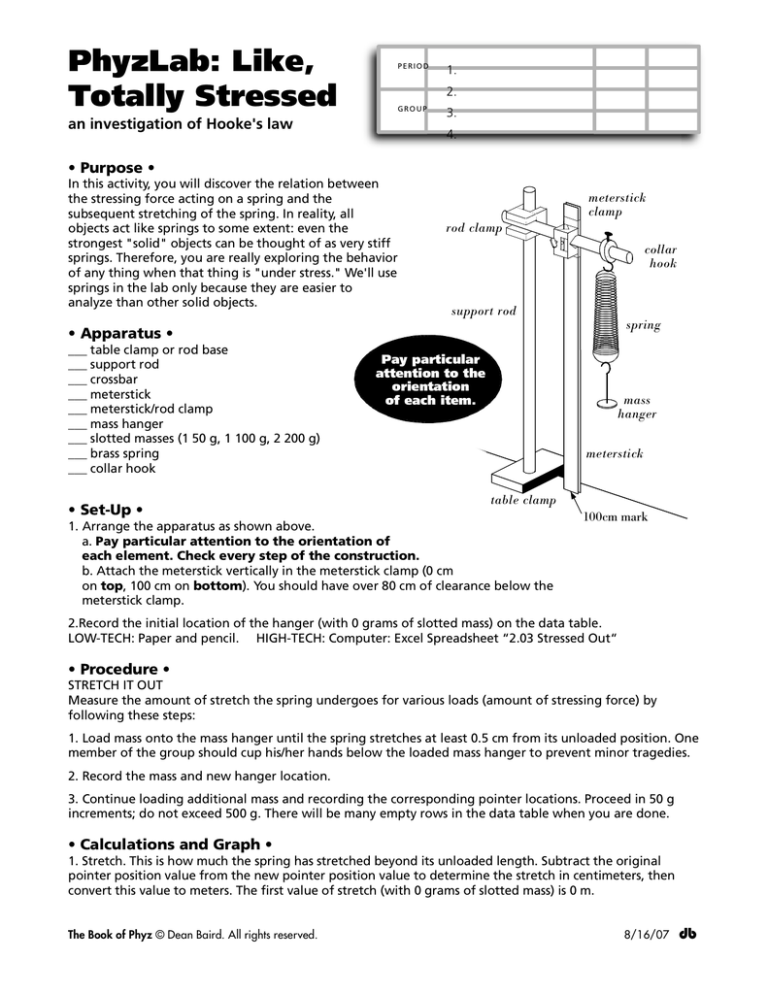
PhyzLab: Like,
Totally Stressed
PERIO D
1.
2.
GRO UP
an investigation of Hooke's law
3.
4.
• Purpose •
In this activity, you will discover the relation between
the stressing force acting on a spring and the
subsequent stretching of the spring. In reality, all
objects act like springs to some extent: even the
strongest "solid" objects can be thought of as very stiff
springs. Therefore, you are really exploring the behavior
of any thing when that thing is "under stress." We'll use
springs in the lab only because they are easier to
analyze than other solid objects.
meterstick
clamp
rod clamp
collar
hook
support rod
spring
• Apparatus •
___ table clamp or rod base
___ support rod
___ crossbar
___ meterstick
___ meterstick/rod clamp
___ mass hanger
___ slotted masses (1 50 g, 1 100 g, 2 200 g)
___ brass spring
___ collar hook
• Set-Up •
Pay particular
attention to the
orientation
of each item.
mass
hanger
meterstick
table clamp
1. Arrange the apparatus as shown above.
a. Pay particular attention to the orientation of
each element. Check every step of the construction.
b. Attach the meterstick vertically in the meterstick clamp (0 cm
on top, 100 cm on bottom). You should have over 80 cm of clearance below the
meterstick clamp.
100cm mark
2.Record the initial location of the hanger (with 0 grams of slotted mass) on the data table.
LOW-TECH: Paper and pencil. HIGH-TECH: Computer: Excel Spreadsheet “2.03 Stressed Out“
• Procedure •
STRETCH IT OUT
Measure the amount of stretch the spring undergoes for various loads (amount of stressing force) by
following these steps:
1. Load mass onto the mass hanger until the spring stretches at least 0.5 cm from its unloaded position. One
member of the group should cup his/her hands below the loaded mass hanger to prevent minor tragedies.
2. Record the mass and new hanger location.
3. Continue loading additional mass and recording the corresponding pointer locations. Proceed in 50 g
increments; do not exceed 500 g. There will be many empty rows in the data table when you are done.
• Calculations and Graph •
1. Stretch. This is how much the spring has stretched beyond its unloaded length. Subtract the original
pointer position value from the new pointer position value to determine the stretch in centimeters, then
convert this value to meters. The first value of stretch (with 0 grams of slotted mass) is 0 m.
The Book of Phyz © Dean Baird. All rights reserved.
8/16/07
db
2. Load Force. This is the weight of the slotted masses. Convert the slotted mass values to kilograms and
multiply that mass by gravitational acceleration to determine the weight of the load.
3. Graph Load Force vs. Stretch. Remember to include all the details of a correctly plotted graph. Draw a
best-fit line through your plot.
4. Use the letter k to represent the slope of the plotted line. Write an expression for the slope (k) in terms
of load (F) and stretch (x).
5. Determine the slope of the line
a. directly from the graph. [HIGH-TECH: Use Excel’s analysis tools.]
b. calculated using measured data. Use several pairs of points and determine an average. (Use the unused
column on the data table.) [HIGH-TECH: Skip.]
6. Determine an equation for this line. (Remember you are working with F vs. x, not y vs. x.) Test your
equation on some of your data to see if it is a reasonable representation. This equation—in the form
F = kx—is Hooke’s Law, named in honor of British physicist Robert Hooke (1635-1703), a contemporary and
bitter rival* of Isaac Newton (1642-1727).
• Unknown •
Obtain an object of unknown mass from your instructor. Use your spring system and the data you have
collected to determine the mass of the object.
1. Describe your method. (Record data in the empty spaces of the original data table.)
2. Record the value you feel is the correct mass of the object in ink:
m = ____________________g.
3. Take the object to your instructor for a determination of the correct mass of the object. Calculate the
percent error of your determination of the object’s mass.
M = ____________________g.
%E = ___________________.
*Newton had all portraits of Robert Hooke destroyed after Hooke’s death.
The Book of Phyz © Dean Baird. All rights reserved.
8/16/07
db
• Analysis •
1. What does the slope of the graphed line indicate?
a. Which ratio better describes the slope?
___Force per stretch
___Stretch per force
b. Suppose a load of 3 N stretched the spring 0.5 m.
i. What is the meaning of 3/0.5 in this context?
ii. What is the meaning of 0.5/3 in this context?
iii. Which of these is also a description of the slope of the graphed line? (Box it.)
2. Suppose another spring were used in the experiment.
a. If the slope of the resulting line were steeper (greater), what would that indicate about the spring?
b. If the slope of the resulting line were shallower (lesser), what would that indicate about the spring?
3. On your graph, add and label a line for a stronger spring. Add and label a line for a weaker spring.
4. Use your graph to determine answers to the following questions.
a. What is the weight of an object that stretches your spring 0.27 m?
b. How far would a 3.25N object stretch the spring?
5. Use your equation (from part 6 of the Calculations and Graph section above) to calculate answers to the
following questions.
a. What is the weight of an object that stretches your spring 0.27 m?
b. How far would a 3.25 N object stretch the spring?
The Book of Phyz © Dean Baird. All rights reserved.
8/16/07
db

